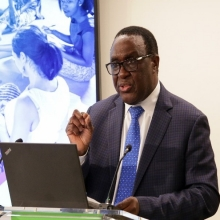5 min read
Summary: To address the deteriorating nutrition security challenge, food security would remain a priority for the African continent in the next coming years. In dealing with this, the African Union member states implemented the Comprehensive Africa Agriculture Development Program to ensure that by 2050, hunger is ended just as the Sustainable Development Goal 2 works to stamp out hunger by 2030. These efforts are quite commendable; however, only modest progress has been recorded. That is to say that there is a need to re-strategize on policies; implementing viable policy goals that are focused on utilizing the science and digital technologies would make the most promising impact.
Key priority for Africa over the next decade should be to address a deteriorating food security situation that is compounded by the effects of climate change, declining agricultural productivity, and rapid population and urbanization growth. Encouragingly, this priority is reflected in initiatives shared by Africa and the world. Already, the African Union member states are committed to ending hunger by 2025 under the Comprehensive Africa Agriculture Development Program (CAADP). Similarly, United Nations Sustainable Development Goal 2 calls for ending hunger and all forms of malnutrition by 2030. Despite these and other commitments, though, progress has been modest with only nine out of 55 African countries currently on track to reduce undernutrition to 5 percent or less by 2025. This insufficient progress underscores the need to redouble efforts. Going forward, policy priorities centered around leveraging science and digital technology, and addressing fragility hold the greatest promise.
LEVERAGING SCIENCE TO ADAPT AGRICULTURE TO CLIMATE CHANGE
Climate change is already affecting agricultural production in Africa, and future projections suggest even worse outcomes. The frequency of droughts has dramatically increased, from an average of once every 12.5 years over 1982-2006 to once every 2.5 years over 2007-2016. These droughts have also become more severe and prolonged, diminishing the productive capacity of the land. Farmers face other climate risks, including lower and erratic rainfall, shorter rainy seasons, and a higher incidence of pests and diseases. By some estimates, Africa could face a near double-digit reduction in crop yields and production volumes over the next decade, as well as rising food prices by similar margins (Figure 4.5). The impacts of these and other indicators are projected to be even larger by 2080.
In places where climate-smart agriculture is practiced today, farmers are seeing increased food security and resilience. In Rwanda, for example, the Land Husbandry, Water Harvesting, and Hillside Irrigation project has helped control erosion, intensify yields on existing land, and provide greater protection from droughts. Under this program, maize yields increased 2.6 times between 2009 and 2018, with even larger increases for beans, wheat, and potatoes.
In Senegal, the West Africa Agricultural Productivity Program has developed new high-yielding, early-maturing, drought-resistant varieties of crops such as sorghum, millet, groundnuts, and cowpeas. These varieties are being widely disseminated to farmers and have raised yields by an average of 30 percent, even with less and more erratic rainfall. Despite the late onset of rains in 2014, with only half the average total rainfall, yields for farmers of improved sorghum and millet varieties increased.
Science offers enormous potential to provide sustainable solutions for food security, including innovations to improve adaptation to climate change, science-based management of productive resources (land, soil, and water), and the storability and transportability of foods to reduce food waste and loss. Leveraging science effectively requires the translation of scientific solutions into packages that can be disseminated and adopted by farmers at scale, both at the farm and landscape levels. This task calls for effective linkages between international, regional, and national science organizations with farmers and extension systems. The solutions should be co-generated between researchers and farmers so that local resilience challenges can be addressed in a demand-driven and knowledge-intensive manner.
HARNESSING DIGITAL TECHNOLOGIES
Sorely needed extension services, which impart new skills to farmers and enhance labor and land productivity, currently are often inadequate and may not always respond to farmers’ changing needs—and so digital technologies can help. Digital tools for monitoring climate risks can identify the onset of climatic shocks before they happen, and facilitate responses for building resilience. Automated irrigation systems, soil sensors, and drones can boost the efficiency of production. Digital tools can enhance food availability and accessibility, as well as improve food utilization and safety through effective monitoring of food hazards. E-commerce platforms can integrate smallholder farmers into value chains and enable them to eliminate the transaction costs of locating demand, determining prices, and improving efficiency in service delivery.
There are several examples from across the globe that highlight the role of technology in transforming the lives of farmers. For example, today, through Hello Tractor, which connects tractor owners with farmers over text message, farmers in Nigeria, Ghana, and Kenya can seamlessly rent machines that they previously had to buy or could not access at all. Over 500,000 farmers have been reached with tractor services. About 60 percent of the farmers report higher productivity and more than 90 percent report overall improvement in quality of life. Platforms such as Digital Green or Plantix can dramatically increase agricultural productivity by making it easier for farmers to acquire new skills for monitoring the quality of their crops. Plantix provides a diagnostic and monitoring tool that allows users to share pictures of sick plants, identify diseases, pests, and nutrient deficiencies, and then send the information back to the community. Such technologies directly help improve productivity along the food value chain.
PREVENTING FRAGILITY AND ADDRESSING ITS CONSEQUENCES ON FOOD SECURITY
The prevalence of undernutrition is about twice as high in conflict-affected areas. The effects of conflicts on food security include disruption of agricultural production activities at the farm level, disruption of postharvest management functions such as marketing and storage, and the weakening of the ability of poor households to recover from shocks. Conflicts create stress on local and national institutions, leading to weak delivery of agricultural services and public infrastructure and low investments at the farm level and in downstream parts of the food system.
Africa cannot address food insecurity without addressing the agriculture-related drivers of conflict and fragility and their consequences. In this context, there is need to manage competition for natural resources in fragile areas, especially between herders and crop farmers. Fragile and conflict-affected areas can be difficult to reach for outsiders. Therefore, it is important to build capacity in local institutions to enable design and implementation of community-based approaches.
Despite the challenges of climate change and state fragility in parts of Africa, the continent has the potential to not only achieve food and nutrition security, but to leverage the food sector for its overall development.
Key Recommendations: In unstable places, competition for natural resources must be managed, particularly between herders and crop growers. Outsiders may find it challenging to access fragile and conflict-affected communities. As a result, it’s critical to establish capacity in local institutions so that community-based initiatives may be designed and implemented.
About the Authors:
Simeon Ehui is Regional Director for Sustainable Development for Africa – World Bank

Holger Kray is a Practice Manager, Agriculture Global Practice – World Bank

Elliot Mghenyi is a Senior Agriculture Economist, Agriculture Global Practice – World Bank

Source: Brookings
Keywords: Policy, Food security, Agriculture, Digital, Technology, Africa

